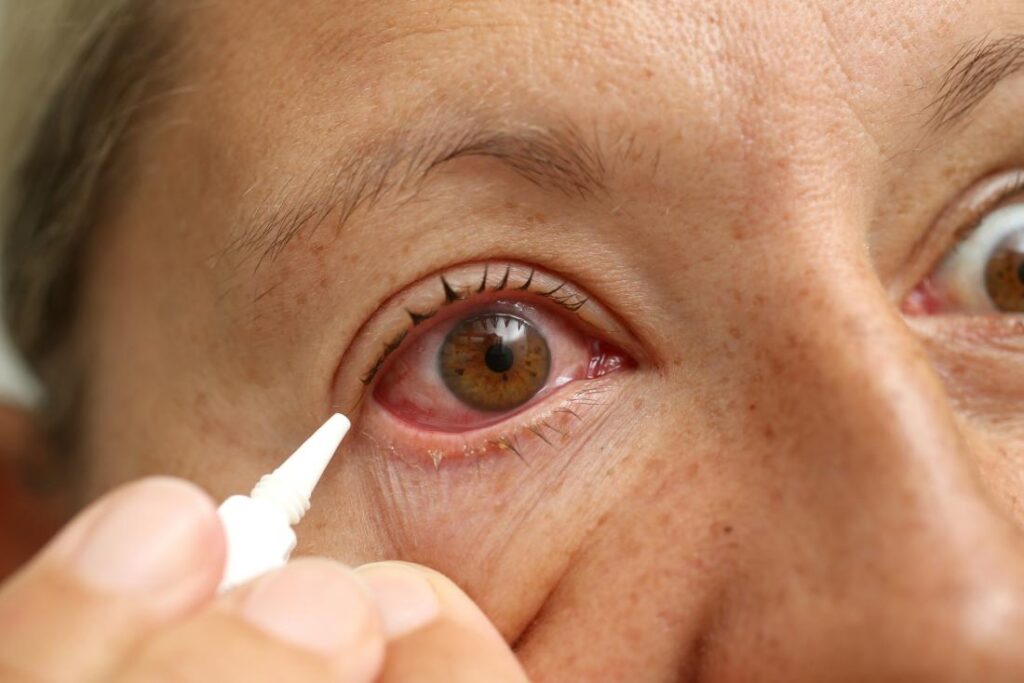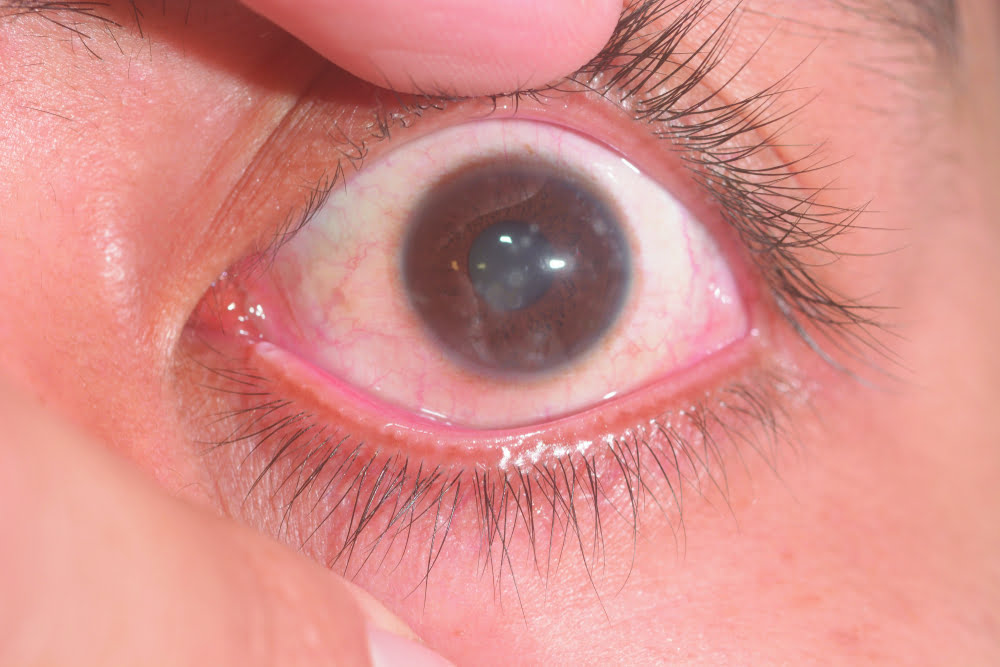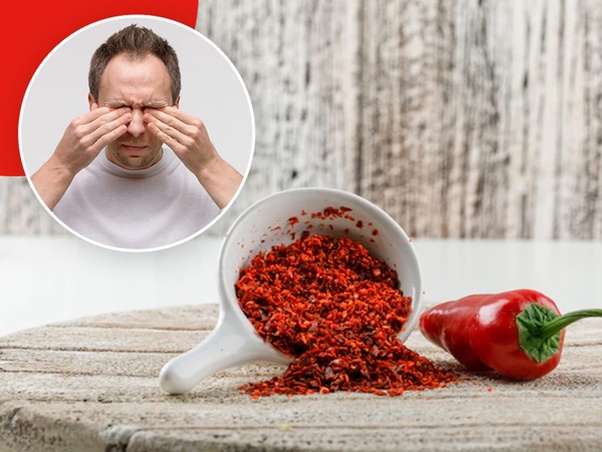No, exposure to chili in the eyes is unlikely to cause permanent blindness. While capsaicin, the compound responsible for chili’s spiciness, can trigger intense pain, tearing, and redness upon contact with the eyes, it generally leads to temporary discomfort. The eye’s natural defense mechanisms, such as blinking and tearing, work to flush out the irritant.
Severe and permanent damage, including blindness, is rare due to capsaicin exposure. Swiftly flushing the eyes with water and seeking medical attention if irritation persists are recommended actions to minimize potential harm.
How does chilli in the eye happen?
Accidentally getting chili in the eye can lead to a distressing and painful experience due to the active compound in chili peppers called capsaicin. Here’s a more detailed explanation of how this can happen:
- Chopping or Handling Chilies
When you handle or chop chili peppers, capsaicin is present in the oils and juices of the pepper. If you touch the chili with your bare hands, capsaicin can transfer onto your skin and under your fingernails. If you don’t wash your hands thoroughly after handling chilies, the capsaicin remains on your skin and can be easily transferred to your eyes when you touch them.
- Rubbing Eyes
If you touch your face, especially your eyes, after handling chili peppers without washing your hands, you can inadvertently introduce capsaicin to your eyes. The sensitive tissues of the eyes are particularly susceptible to the effects of capsaicin, leading to an intense burning sensation.
- Cooking and Stirring
When cooking dishes that involve chili peppers, such as stirring a chili-based sauce or curry, tiny particles containing capsaicin can become airborne due to heat and movement. These particles can land on your skin or be inhaled. If they come into contact with your eyes, they can lead to irritation and discomfort.
- Contaminated Surfaces
Even if you handle chili peppers carefully, capsaicin can still be present on surfaces like cutting boards, countertops, and utensils. If you touch these surfaces and then touch your face, especially your eyes, you can transfer capsaicin and cause irritation.
- Wind or Air Movement
Working with dried chili peppers or chili powder in outdoor settings or areas with air circulation can result in capsaicin particles becoming airborne. Wind or air movement can carry these particles into your eyes, causing irritation.
- Unintentional Transfer
In social situations, if you handle or eat foods that have chili on the surface and then touch your eyes, you can unknowingly introduce capsaicin to your eyes. This can happen if you interact with finger foods, for instance.
- Children and Accidental Touch
Children who might not fully understand the effects of capsaicin can touch chili peppers or foods containing chilies and then inadvertently touch their eyes. Their curiosity and lack of awareness can lead to accidental exposure.
What can happen if the chilli gets in your eyes?

If chili, chili powder, or any substance containing capsaicin comes into contact with the eyes, it can lead to a range of uncomfortable and potentially painful symptoms. Capsaicin is the compound responsible for the spiciness of chilies, and when it interacts with the sensitive tissues of the eyes, it can cause:
- Burning Sensation
When capsaicin, the active compound in chili peppers responsible for their spiciness, comes into contact with the delicate tissues of the eyes, it triggers an intense burning sensation. This sensation can be described as a sharp, stinging pain that can range from mild discomfort to excruciating pain, depending on the concentration of capsaicin and the amount of exposure.
- Redness and Irritation
The eyes will often become red and irritated due to the inflammation caused by capsaicin. This redness can extend to the whites of the eyes and even the surrounding eyelids.
- Tearing and Watery Eyes
The body’s natural response to the irritation caused by capsaicin is excessive tearing. The eyes may water profusely in an attempt to wash away the irritant and alleviate the discomfort.
- Swelling
The eye tissues, particularly the conjunctiva (the clear tissue covering the front of the eye) and the eyelids, may become swollen due to the inflammatory response. This swelling can contribute to the overall discomfort.
- Blurred Vision
The combination of the burning sensation, tearing, and swelling can lead to temporary blurred vision. It can be challenging to keep the eyes open and focus properly.
- Sensitivity to Light (Photophobia)
Some individuals might experience heightened sensitivity to light during and after exposure to capsaicin. This sensitivity, known as photophobia, can exacerbate the discomfort, making it difficult to tolerate even normal levels of light.
- Discomfort and Pain
The overall discomfort and pain caused by capsaicin exposure can be distressing and even incapacitating. It might be hard to engage in normal activities due to the intensity of the sensations.
- Corneal Abrasion (Less Common)
While less common, intense rubbing of the eyes or excessive tearing caused by the irritation can lead to a corneal abrasion. A corneal abrasion is a scratch on the surface of the cornea (the clear front part of the eye), which can cause additional pain, watering, and potentially blurry vision.
How to prevent the chilli from getting into your eye?
Preventing chili from getting into your eyes requires careful handling and awareness. Here are some tips to help you avoid accidentally getting chili in your eyes:
- Wear Gloves
When handling particularly spicy chilies or when chopping a large quantity of chilies, consider wearing disposable gloves. This prevents direct contact between your skin and the capsaicin-containing oils in the chilies.
- Wash Hands Thoroughly
After handling chili peppers, wash your hands thoroughly with soap and water. Pay attention to all parts of your hands, including under your fingernails, where capsaicin can linger.
- Avoid Touching Face
Be conscious of not touching your face, especially your eyes, while handling chili peppers. Even a small touch can transfer capsaicin to your eyes.
- Use Utensils
Use utensils like knives, forks, or spoons to handle chilies instead of your bare hands. This reduces the chance of capsaicin coming into contact with your skin.
- Wear Eye Protection
If you’re frequently working with chili peppers or doing tasks like grinding dried chilies, consider wearing protective eyewear like goggles. Goggles shield your eyes from airborne particles that can contain capsaicin.
- Avoid Rubbing Eyes
Be mindful not to rub your eyes while you’re handling chili peppers, even if you believe your hands are clean. Rubbing can transfer capsaicin and lead to discomfort.
- Clean Surfaces and Utensils
After using cutting boards, knives, or utensils to handle chilies, thoroughly wash them with soap and water to remove any capsaicin residue. This prevents cross-contamination that could lead to accidental exposure.
- Cook in Well-Ventilated Areas
When cooking dishes that involve chili peppers, ensure the cooking area is well-ventilated. Proper ventilation reduces the chances of capsaicin particles becoming airborne and reaching your eyes.
- Teach Children
If you’re working with chilies and there are children around, educate them about the potential risks and the importance of not touching their eyes after handling chilies.
- Use a Grinder or Food Processor
If you need to process a large quantity of chili peppers, consider using a grinder or food processor to minimize direct contact.
- Wash Before Removing Contacts
If you wear contact lenses, make sure to wash your hands thoroughly before removing them. Capsaicin can adhere to contacts and cause discomfort.
- Be Cautious at Meals
When eating dishes with chili peppers, be cautious not to touch your face, especially your eyes, with chili-covered fingers.
By taking these precautions, you can significantly reduce the likelihood of accidentally getting chili in your eyes. Remember that prevention is key, but if an accident does happen, follow the steps mentioned earlier to minimize discomfort and potential damage.
What should you do if you accidentally get chilli in your eye?

If you accidentally get chili or chili-related substances in your eye, it can be an uncomfortable and painful experience due to the capsaicin, the compound responsible for the spiciness of chilies. Here’s what you should do immediately to minimize the discomfort:
- If you’re still near the source of chili exposure, immediately stop handling chili peppers or any chili-related substances to prevent further contamination.
- Before touching your eyes, thoroughly wash your hands with soap and water. Ensure you clean your hands and under your nails, as capsaicin can linger on your skin.
- Quickly and gently flush your eyes with cold water. Use a gentle stream of water from a faucet or a clean cup filled with water to rinse your eyes. Open your eye while flushing to help wash away the capsaicin.
- While flushing, try to keep your eye open to ensure that the water reaches the entire surface of the eye.
- Blink your eyes and roll your eyes around while flushing to help distribute the water and remove the capsaicin.
- Repeat the flushing process for several minutes to ensure thorough rinsing. The cooling effect of the water can help alleviate the burning sensation.
- After flushing with water, you can soak a cotton ball or a clean cloth in cold milk and gently dab it on your closed eyelid. Milk’s fat content can help neutralize the effects of capsaicin.
- After rinsing with water and using milk, you can use over-the-counter lubricating eye drops. These drops can provide additional relief by soothing the eye and diluting the capsaicin. Follow the instructions on the eye drop packaging for proper usage.
- If you wear contact lenses, remove them to avoid trapping capsaicin against the surface of your eye. If possible, switch to eyeglasses temporarily until the irritation subsides.
- Refrain from rubbing your eye, as this can spread the capsaicin and worsen the irritation.
- If the burning sensation persists, the discomfort is severe, or you experience blurred vision, excessive tearing, or any concerning symptoms, it’s best to seek medical attention from an eye doctor (ophthalmologist). They can assess the situation and provide appropriate treatment.
FAQs
Can you treat chilli in the eye at home?
Yes, you can treat chili in the eye at home. Flush the eye with cold water for 10-15 minutes to remove capsaicin. Use milk-soaked cotton for relief or lubricating eye drops. Avoid rubbing, and if symptoms persist or worsen, seek medical attention.
How long does chilli burn last in the eyes?
The duration of chili burn in the eyes varies. Mild cases may ease within a few hours, but intense exposure can cause discomfort for up to 24 hours. Immediate flushing, using remedies, and refraining from rubbing can expedite relief. If the burn persists, seeking medical guidance is advised.
Can chilli cause permanent damage?
No, chili exposure to the eyes rarely results in permanent damage. Nonetheless, intense exposure can cause corneal abrasions, temporary visual disturbances, or worsen underlying conditions. Timely and appropriate treatment usually averts lasting effects. If concerned, consult an eye doctor for assessment and guidance.
Does eating chilli affect eyesight?
No, eating chilli doesn’t affect eyesight permanently. However, consuming extremely spicy foods might lead to temporary discomfort, tearing, or sensitivity to light due to the body’s response to capsaicin. These effects are transient and shouldn’t cause lasting damage to eyesight.
What are the possible complications of chilli in the eye?
Possible complications of chili in the eye include corneal abrasions resulting from rubbing the irritated eye, exacerbation of existing eye conditions like dry eye or conjunctivitis, and susceptibility to secondary bacterial infections due to irritated tissues. Severe exposure might lead to prolonged discomfort or blurred vision. Swift and proper treatment minimize risks; consult an eye doctor if concerned.
Final verdict
Chilli in the eyes won’t lead to blindness, but capsaicin exposure causes temporary discomfort. Swift flushing and medical attention alleviate risks. Understand prevention, immediate response, and potential complications. Empower yourself with insights to protect your eyes.
Discover how to ensure safety without panic. Your vision matters — explore our concise guide for practical advice and proactive measures. Don’t let chili mishaps compromise your eye health.











